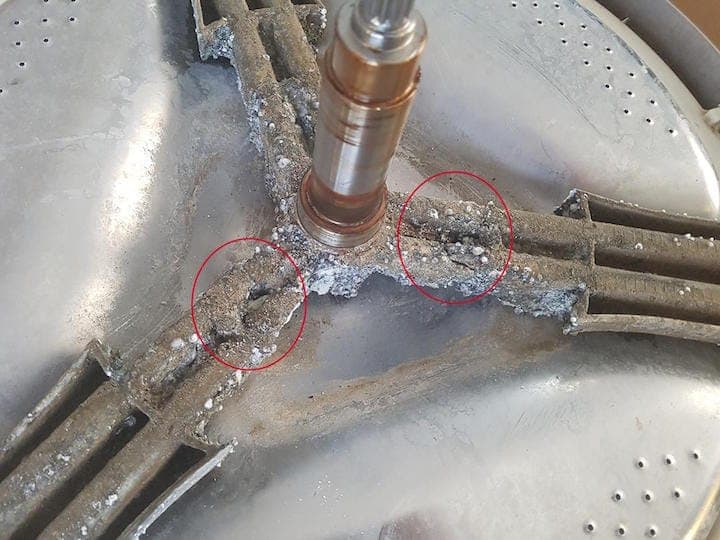There’s a confirmation bias aspect to this. There were a lot of things made in the 70s that did not keep working for fifty years. You don’t think of them because they’re already broken down for parts, recycled or buried in a landfill. There are some things that have kept working only because someone put regular care and maintenance into them.
There are a lot things made today that won’t make it fifty years from now. There are some things that will.
If disposable culture concerns you, learn how to repair things (clothes, kitchen appliances, furniture, electronics, etc) and buy things that can be repaired (like the Framework laptop).
But that’s something that I witnessed change since the 80’s and makes the electronic crappier, it’s the fact that appliances in the 70’s-90’s were incredibly easy to fix. It was not rare for the manufacturer to even give schematics in the user’s manual. There were shops to repair stuff everywhere and it was something approachable by anyone who could hold a soldering iron.
They also had a far higher price. This changed the effective disposability. E.g. you likely wouldn’t pay $500 to fix a $400 washing machine. If it were a $10,000 washing machine, it’s more reasonable.
This is why TV repair shops disappeared. TVs got cheap enough that the labour cost would outweigh the replacement cost. I recently fixed a TV with a dodgy backlight. The parts cost £12, but it took me a few hours. If my time was factored in, in a business manner (including accounting for downtime, profit ,and expenses) it would have been over 75% of the replacement cost.
Also, a lot of newer features add complexity and make for more difficult repairs.
Eh, not really. If anything it’s easier because all you have to do is swap out circuit boards instead of soldering in new parts.
This. I had a winterized display (leaky roof inspired water damage) and replaced a board and fixed it. Took about 20 min including the time to disassemble the tv itself. $20.
The research to figure out what components caused the problem was significant, however. Because tv repair isn’t a thing anymore even tho it absolutely should be.
FWIW I think this is technically survivorship bias, not confirmation bias (but maybe the latter is a form of the former?)
I do agree, there is probably a lot of shit from the 70s that stopped working early on. On the other hand, I do feel like planned obsolescence is a thing. Look at Instant Pot. They’re going bankrupt because everyone already owns an Instant Pot and they all still work.
https://www.theatlantic.com/technology/archive/2023/06/instant-pot-bankrupt-private-equity/674414/
The problem in my eyes the failure is in the private equity firm that bought them trying to draw blood from a stone, not the Instant Pot.
Yes, they came out with a 1000 SKU’s and over extended themselves to flood the market with the instapot brand. I saw an instapot coffee maker.
Being built to be maintainable and parts shops being common also helped a lot of those things be maintained as well. They didn’t even need to be as robust when replacing a part or two was cheap and easy. Now the issue is hard to identify due to complexity and finding replacement parts is so expensive or time consuming that just replacing it is less of a hassle.
Like I did basic maintenance for bearings and belts on a knob and switch only washer we bought in 2004. It lasted for almost 20 years with one service call to replace water seals because I didn’t trust myself to get it right. Now we have a 3 year old front loading washer with a bunch of bells and whistles that have already stopped working shortly after the warranty expired that makes horrible noises which I won’t work on because everything is a pain to get to and they are just way too complex.
Now we have a 3 year old front loading washer with a bunch of bells and whistles that have already stopped working shortly after the warranty expired that makes horrible noises which I won’t work on because everything is a pain to get to and they are just way too complex.
Especially if it’s a Samsung, I bet it’s the “spider arm” and that the horrible noises are the fractured chunks of metal banging against each other when it tries to spin the drum.
Every fucking water-exposed part in those things is immaculate stainless steel, except for the spider arm which is blatantly designed to corrode to death just as the warranty ends.

learn how to repair things
Most appliances are not easy to fix because its just a circuit board connected to a machinary, unlike appliances of the past which had mechanical components.
Now, knobs and buttons are replaced by a touchscreen and good luck fixing that on your own.
I remember when one of our local publications asked their readers “what kind of old appliances you still have around at home that you use regularly?” and the article was flooded with photos of 1970s kitchen appliances. Well duh, of course those still work, if you take them out of the cupboard once a year to bake a cake or whatever.
there are companies whose whole ethos is “buy company with good reputation for quality then use that to sell less quality stuff but we get richer then drive it into the earth and sell off the bones of the reputation we ruined for our personal profit” which is similar to enshtification but not the same thing because it was happening without a web layer.
with the web layer added into the equation it is even easier.
enshittification basically
The term is Vulture Capitalism
Scwhinn bicycles for example
Back in the day there wasn’t 56 versions of $product for cheap. There were maybe 3, and people talked. Products cost real money and we were concerned about quality and lasting power.
So yeah, we had better shit because reputation was a big deal.
They also cost 4x what they do today when adjusted for inflation.
This is the real answer to me. Often, the premium version is still out there but people go for the budget version anyway. That’s not necessarily a bad thing though. When we can furnish a whole room for what a couple pieces used to cost, that’s a win for a lot of people even if some of those items wear out prematurely. It also depends if we’re talking about a mostly mechanical and utilitarian item, vs something that relies on modern software ecosystems. Toasters haven’t changed much in 40 years, but a 10 year old cell phone is pretty much useless, possibly not working at all with current network technology. Durability is less important when an item becomes technologically obsolete anyway.
There may be premium versions that are high quality, but too often the premium version is made with planned obsolescence as well these days. There’s generally no way of knowing if you’re paying extra for quality of for the privilege of showing off the money you spent
Looking for commercial type products and checking the website for parts/manuals can go a long way. Doesn’t always guarantee that those parts will still be available in a decade or two, but it shows the company at least making an effort to support those products. You’re paying up front though, that commercial product can be 5-10x the cost of the equivalent consumer model. Heck, sometimes people still buy those consumer models because it’s a lot easier to justify a $100-$200 price tag every, even if you expect to replace it every few years than $1000+ up front.
They also were made with no safety or environmental considerations in mind.
Adjust wages for inflation, still not bad
Nowadays the main question is whether it’s open source or not. Anything closed source sucks, or will imminently suck. The more open source it is, the more modular, the more repairable, etc.
Yes this goes for hardware too.
Another point: Avoid ‘smart’ devices at all costs. They are hardware spyware, full stop, and will stop working whenever it is deemed you need to buy a new one.
What we’re avoiding is capitalist opportuism hidden in tech and the solution for that is not to find a good provider. The solution is to find a provider that has a ‘business model’ that protects against the brunt of this extractive BS.
Numerous examples: 1.Newer version of software mutating into buggy, crashy mess, while old versions worked perfectly. Forced upgrades and stealth upgrade that remove functionality(e.g. cloud-only/online-only service)
2.Newer versions of products dropped quality, even using cheaper materials. The subreddit /r/Chinesium has lots of these.
3.Websites redesigned to load much slower and waste tons of memory without any benefits, just because it fashionable to load 3-4MB of js framework code.
4.Websites breaking on older browsers and demanding latest Chrome/Firefox to run(Web Components,latest JS features), with functionality declining.
5.Companies intentionally crippling products and offering the older functionality as premium services.
6.Technology regressing towards simpler and more primitive forms because complexity requires quality(and its more expensive).
7.Software development regressing towards forms where its built by composing code copied from Stack Overflow and AI generation.
8.Environmental degradation increasing despite more stringent laws, regulation and enforcement. Microplastics, endocrine disruptors, even a regression in ozone layer due some Chinese factories.
You missed 9. Survivorship bias. Appliances that stopped working between 1970 and now would be in a landfill, only those that are still working are worth noting.
The other points are great though!
The solution to all/most of these points is open source software & hardware.
A small detail, but 3-4MB of JS? That’s nothing, just ads alone can consume that.
deleted by creator
But also a fridge from the 70s leaked ozone killing gas, consumed more electricity and provided less even cooling than cheap modern fridges.
Let’s not pretend the past was strictly better.
Plus it’s survivorship bias. All the stuff from the 70s that broke was replaced, so we’re left with the things that are more durable.
deleted by creator
deleted by creator
Tv use to be furniture. It’s crazy.
Cars weren’t we safe but they were more affordable and repairable.
I won’t touch any of my modern cars but I work on my older cars call the time.
The Sunbeam T-20 toaster from 1949 is the pinnacle of both engineering and design. You put the bread, or bagel, or pop tarts in, and everything comes out perfectly toasted. No buttons, no transistors, only a small knob to set preferred darkness. It knows it’s ready when the radiated heat off the food causes a small bimetal component to expand at different rates, bend, and trip the release to raise the toast. Set it once on a piece of bread and it’s the same level of toastiness for everything you put in there. And it looks space-agey and timelessly cool.
It automatically lowers the bread down too.
It’s “automagic beyond belief!” One of the best eBay purchases I’ve ever made.
Refrigerators, washers and dryers, dishwashers, stoves, shit even cars ALL used to be able to last a lifetime. Now though we have planned obsolescence and we pay the same price or more for shitty versions of the shit DESIGNED TO FAIL in like 20 years at best
I have a secondhand Kenwood KA-3020SE amp on my desk from the 90s. PDF service manual containing the schematics and all. The thing is still perfectly usable, despite the relays for Output B needing replacement, and the input switching knob needing a good clean. The prominent, physical volume knob is a pleasure to use, and the 1/4 headphone jack’s output power beats everything else in my house.
I have a problem though. It’s absolutely massive, and I’m pretty constrained with desk space. But I haven’t found anything remotely capable of replacing it. Given how I came to possess the amp in the first place, I’m pretty sure it’s been through several owners before getting to me - and it’d be nice if the next owner had an interest in continuing to care for it.
If I do replace it though, I doubt the next one will last as long as this has, seeing how modern stuff these days isn’t always built to last
I have two solutions for you. One is a shelf (without any elf), the other is to give it to me (proud owner of one shelf).
There is an Antonov An-2 stationed at my city’s airport. I checked the tail number - it entered service in the 50s and only recently had its engine changed.
There are stories of B52 pilots flying the same plane as their grandfather. Not just flying but still in active military service.
I suspect that 99% of the parts have been replaced through maintenance or upgrades, but technically, it is still the same plane.
With parts and maintenance machines can last virtually forever.
but technically, it is still the same plane.
Ahh, the Ship of Theseus
There are still Douglas DC-3’s in active use.
Survivorship bias.
We didn’t experience the numerous appliances and other detritus from the 70’s that crapped out and died. The ones whose safety policy began and ended with the power of prayer.
I have no idea what 2024 will bring us. It feels like the entire world is shaking itself apart. But I can promise you with 100% certainty that in 2064 they’ll be lamenting that their appliances aren’t built as good as they used to.
Yeah nah…
Take fridges for example. Producers added features like automatic defrosting, freezer on the bottom, ice maker, etc. All of those add complexity, and require parts that break down.
40 years ago a fridge was basically just a pump and a condenser in a box. There’s not a lot of things to break down with that setup, and that’s why they’re still working perfectly fine. You don’t need a whole system to pump cold air from the bottom of the fridge to the top, you just stick the condenser at the top and let physics do the rest.
There seems to be more to it than that.
Planned obsolescence is a very real thing, and appliances can be designed to die sooner than they have to.
Aside from that, a lot of tech got unnecessarily complex, thereby raising chances of something breaking naturally, without even PO in mind.
On average, tech from 70’s actually was more reliable, even though it’s not AS reliable as some peoppe think exactly due to survivorship bias.
My parent’s clothes iron is a marvel. It feels and looks like a brick but it works ridiculously well. In fairness I’m comparing it against a $30 iron, but it was probably a similar investment for them when they first got it, when my dad was still at university
We certainly have lost spelling and punctuation.
no we haven’t, those are only used in certain contexts to convey certain tones
Collectively, the idea from meeting a long lost high tech society might originate from a time when roman works seemed built by “giants”
High chance that they didn’t actually believed it was really built by humongous gentlemen, but often they were seen as someone with unparalleled technology at that age.
That could be one of the reasons why the Roman (and greek) classic civilizations where so much romanticized.
I visited a Roman fort a while back, after quite a spate of visiting medieval castles. It really is amazing how advanced the Romans were compared to the dark ages that followed the fall of the empire (in Britain, specifically).
To some degree that’s a real thing. We do live in a more disposable society today. It seems worse than it actually is though. You don’t see all the cheap crap from the 70s, because most of it is long gone, and there will still be stuff from today around in 50 years.
Same thing I say when people say “CG is terrible I want practicals.” Folks there are a lot of forgettable - and some memorable for their sheer shittyness - practical effects in Hollywood’s history lol
People complain because it doesn’t make sense to use CG for everything. I’m still mad that The Thing 2 still hasn’t offered its original practical cut.
Ok but that’s what bad movies do and good CG you don’t notice! I always use Sicario as an example. It’s a masterclass in knowing what CG can and can’t do, because it’s everywhere in that movie and most people have no clue. Hell the border fence as they drive to the border is all CG.
I’m not saying that CG should be avoided but that it doesn’t make sense to use it all the time. And it’s funny, the CG in Sicario was actually what got me interested in landscape alteration in movies. Artists have been able to perfectly craft and rearrange landscapes in CG for a long while. I have no issue with it. Now when you uncannily CG a baby or Robert deniro for 2 hours, my eye twitches.
I understand what you’re saying, but nobody is saying it should be used all the time, least of all me. I don’t really know what you’re responding to.
Like any tool it can be used lazily and excessively. I don’t think you’re gonna find a lot of people that disagree with that statement lol
Yeah, I also think part of the issue is that people don’t want to spend a ton of money on something. If you spend more money on things today, you will (generally) get higher quality items. Of course if you spend less, the company will cheap out in places.
This isn’t always true, but a good general rule.
Of course when a company turns a $200 item into a $20 they cut corners, but you need to ask yourself if those concessions actually matter for your use case.
If your appliances are breaking within a short time, you really should buy second hand or if you want new ones you have to spend a bit more. Many of them you spend 50% more, but they last three times longer and more making it a bargain. You obviously need to take care of them, which mainly means keeping them clean. Other then that simple ones can be repaired relatively well, unless they are fridges or freezers. Those need some expertise.















